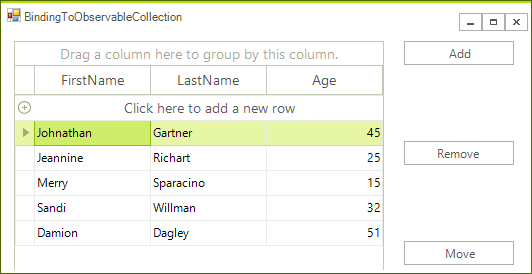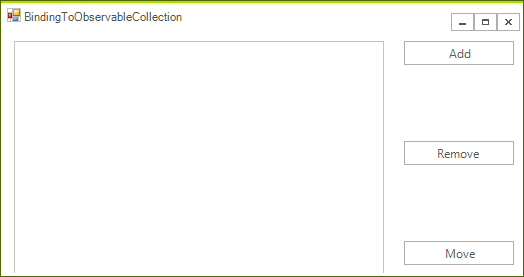Binding to ObservableCollection
The example bellow demonstrates how to bind RadGridView to an ObservableCollection. This collection represents a dynamic data collection that provides notification when changes (add, move, remove) occur.
This collection is available in .NET version 4.0 and above. For this reason it is only supported in the .NET4.0 version of our assemblies (the ones with suffix .40), so please make sure to use those in order to take advantage of this functionality.
The example creates an ObservableCollection of Person, initializes the collection and assigns it to the grid's DataSource property. There are also three buttons allowing the user to add, remove and move items from and in the collection. The changes in the collection are automatically reflected by the grid.

1. First place a RadGridView and 3 buttons on a blank form. Name the buttons accordingly:

2. Add the following sample class to the project:
public class Person
{
public string FirstName { get; set; }
public string LastName { get; set; }
public int Age { get; set; }
public Person(string firstName, string lastName, int age)
{
this.FirstName = firstName;
this.LastName = lastName;
this.Age = age;
}
}
Public Class Person
Public Property FirstName() As String
Get
Return m_FirstName
End Get
Set(value As String)
m_FirstName = value
End Set
End Property
Private m_FirstName As String
Public Property LastName() As String
Get
Return m_LastName
End Get
Set(value As String)
m_LastName = value
End Set
End Property
Private m_LastName As String
Public Property Age() As Integer
Get
Return m_Age
End Get
Set(value As Integer)
m_Age = value
End Set
End Property
Private m_Age As Integer
Public Sub New(firstName As String, lastName As String, age As Integer)
Me.FirstName = firstName
Me.LastName = lastName
Me.Age = age
End Sub
End Class
3. Define the collection along with the function that initializes it:
private System.Collections.ObjectModel.ObservableCollection<Person> people = new System.Collections.ObjectModel.ObservableCollection<Person>();
private void IntilalizeCollection()
{
people.Add(new Person("Johnathan", "Gartner", 45));
people.Add(new Person("Jeannine", "Richart", 25));
people.Add(new Person("Merry", "Sparacino", 15));
people.Add(new Person("Sandi", "Willman", 32));
people.Add(new Person("Damion", "Dagley", 51));
}
Private people As New System.Collections.ObjectModel.ObservableCollection(Of Person)()
Private Sub IntilalizeCollection()
people.Add(New Person("Johnathan", "Gartner", 45))
people.Add(New Person("Jeannine", "Richart", 25))
people.Add(New Person("Merry", "Sparacino", 15))
people.Add(New Person("Sandi", "Willman", 32))
people.Add(New Person("Damion", "Dagley", 51))
End Sub
4. Add the following event handlers for the buttons:
private void Add_Click(object sender, EventArgs e)
{
people.Add(new Person("Damion", "Dagley", 51));
}
Private Sub Add_Click(sender As Object, e As EventArgs)
people.Add(New Person("Damion", "Dagley", 51))
End Sub
private void Remove_Click(object sender, EventArgs e)
{
if (people.Count > 0)
{
people.RemoveAt(0);
}
}
Private Sub Remove_Click(sender As Object, e As EventArgs)
If people.Count > 0 Then
people.RemoveAt(0)
End If
End Sub
private void Move_Click(object sender, EventArgs e)
{
people.Move(people.Count - 1, 0);
}
Private Sub Move_Click(sender As Object, e As EventArgs)
people.Move(people.Count - 1, 0)
End Sub
5. Finally just call the InitializeCollection method to populate the collection and bind the RadGridView to it
private void BindingToObservableCollection_Load(object sender, EventArgs e)
{
IntilalizeCollection();
this.radGridView1.DataSource = people;
}
Private Sub BindingToObservableCollection_Load(sender As Object, e As EventArgs) Handles MyBase.Load
IntilalizeCollection()
Me.radGridView1.DataSource = people
End Sub
Now each change you introduce to the collection by pressing the buttons will be automatically reflected in RadGridView.